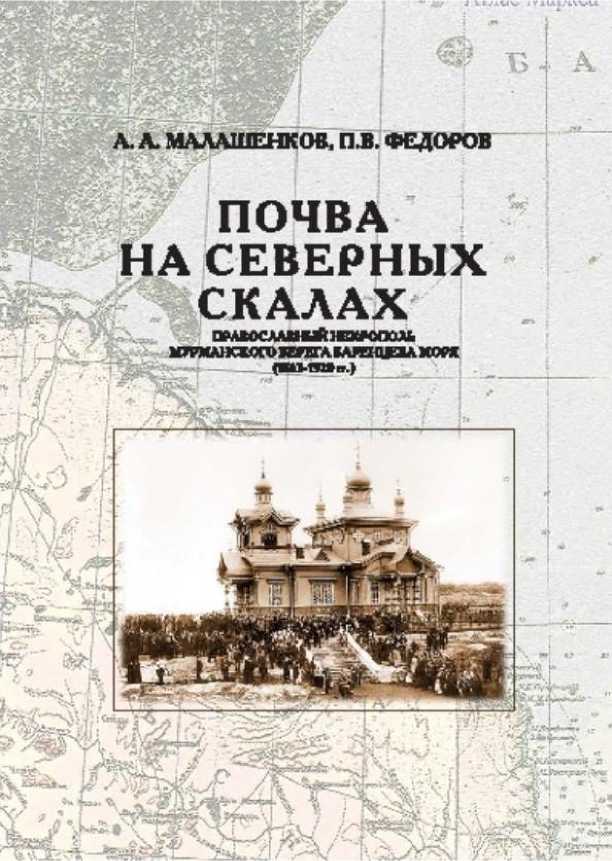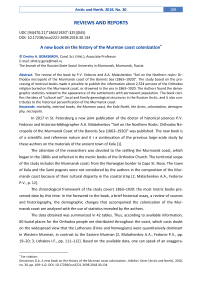A new book on the history of the Murman coast colonization
Автор: Dmitry A. Gerasimov
Журнал: Arctic and North @arctic-and-north
Рубрика: Reviews and reports
Статья в выпуске: 30, 2018 года.
Бесплатный доступ
The review of the book by P.V. Fedorov and A.A. Malashenkov “Soil on the Northern rocks: Orthodox necropolis of the Murmansk coast of the Barents Sea (1863–1920)”. The study based on the processing of metrical books made it possible to publish the information about 2,524 persons of the Orthodox religion buried on the Murmansk coast, or drowned in the sea in 1863–1920. The Authors found the demographic statistics related to the appearance of the settlements with permanent population. The book clarifies the idea of “cultural soil”, local and family-genealogical structures in the Russian Arctic, and it also contributes to the historical personification of the Murmansk coast.
Mortality, metrical books, the Murman coast, the Kola North, the Arctic, colonization, demography, necropolis
Короткий адрес: https://sciup.org/148318551
IDR: 148318551 | УДК: [94(470.21)”1863/1920”:325](045) | DOI: 10.17238/issn2221-2698.2018.30.134
Текст научной статьи A new book on the history of the Murman coast colonization
In 2017 in St. Petersburg a new joint publication of the doctor of historical sciences P.V.
Fedorov and historian-bibliographer A.A. Malashenkov “Soil on the Northern Rocks: Orthodox Necropolis of the Murmansk Coast of the Barents Sea (1863–1920)” was published. The new book is of a scientific and reference nature and it i a continuation of the previous large-scale study by these authors on the materials of the ancient town of Kola [1].
The attention of the researchers was devoted to the settling the Murmansk coast, which began in the 1860s and reflected in the metric books of the Orthodox Church. The territorial scope of the study includes the Murmansk coast: from the Norwegian border to Cape St. Nose. The town of Kola and the Sami pogosts were not considered by the authors in the composition of the Murmansk coast because of their cultural disparity in the coastal strip [2, Malashenkov A.A., Fedorov P.V., p. 12].
The chronological framework of the study covers 1863–1920: the most metric books preserved date by this time. In the foreword to the book, a brief historical essay, a review of sources and historiography, the demographic changes that accompanied the colonization of the Murmansk coast are analyzed with the use of statistics revealed by the authors.
The data obtained was summarized in 42 tables. Thus, according to available information, 60 burial places for the Orthodox people are distributed throughout the coast, which casts doubt on the widespread view that the Lutherans (Finns and Norwegians) were quantitatively dominant in Western Murman, in contrast to the Eastern Murman [2, Malashenkov A.A., Fedorov P.V., pp. 19–20; 3, Ushakov I.F., pp. 111–112]. Based on the available data, one can speak of an exaggera-
∗ For citation:
tion of the significance of the Norwegian factor in the colonization of the Murmansk coast, as some modern authors from Norway do [2, Malashenkov A.A., Fedorov P.V., pp. 6–7].

Fig. 1. The cover of the book “Soil on the Northern Rocks:
Orthodox Necropolis of the Murmansk Coast of the Barents Sea (1863–1920)”
And if during the First World War, Murman coast was inhabited by the natives of most provinces of the Russian Empire, then until 1914, migration was found mainly in the Kola North and the Arkhangelsk Province. Thus, the seasonal colonization of the Murman, which began with the efforts of Russian fishermen at the dawn of fishing in the 16th century and lasted for three centuries, became a prologue to the settlement during the governmental colonization [2, Malashenkov A.A., Fedorov P.V., p. 22].
The peculiarity of the Murmansk coast was the lower average life expectancy compared to the rest of the country. In addition, the authors noted that men mortality for was twice higher than the women one. Thus, the main population of the Murmansk coast was the coming population, but this imbalance slowly declined by the First World War, which, according to the authors, witnessed the formation of a permanent, quite rural population on Murman.
The authors paid much attention to the study of mortality for various reasons and considered all the cases, indicated in the metric books. The first places in the causes of death were infectious diseases — 38.2%, infants — 20.1%, and drowning — 8.2%. Thus, there were sanitary and hygienic problems on the Murman, burdened with inadequate medical care [2, Malashenkov A.A., Fedorov P.V., p. 24].
The main part of the book is a set of all the dead on the Murmansk coast according to the data of metric books, which includes information on 2,524 persons: anthroponomical data, dates of birth and death, social status, causes of death, place of death registration, and burial place.
The sex-age structure presented in the tables includes only four age groups: 0–3, 4-15, 1659 and above 60. The use of such intervals does not give full possibility to trace the exact demographic dynamics. Perhaps it was better to use a more fractional structure or, as for women, it was possible to single out a group of women of reproductive age — 15–49 years. To visualize the age and sex structure of the population of Murman, one can use the so-called “age-sex pyramid”, e.g., according to the census 1897.
It is regrettable that the co-authors did not monitor the dynamics of demographic indicators within the annual cycles related to the seasonality of fisheries, as in the previous work [1, Malashenkov A.A., Fedorov P.V., pp. 10–16].
The researchers used the data of metric books on the city of Murmansk for 1916–1920 and put into circulation the names of the town's first inhabitants, founded in 1916. At the same time, the information on Murmansk does not fully cover the mortality rate during this period. The authors acknowledged it and wrote that metric books reflected information about that part of the population “who recognized and observed the Orthodox rites” [2, Malashenkov A.A., Fedorov P.V., p. 16].
After the Whites in Murmansk, several dozen people were buried at the site of the future monument to the Victims of the Revolution [4, Fedorov P.V., Sinitsky A.N., p. 155–156]. Basically, they were depleted prisoners of the Iokanskyaya prison, transported to Murmansk shortly after the establishment of the Soviet power. The authors give only 4 names of the victims, who died during the pro-Bolshevik coup on February 21, 1920 and recorded in metric books [2, Malashenkov A.A., Fedorov P.V., p. 15]. So, there were more victims, of course [5, Gerasimov D.A., p. 164–166]. However, this remark is more likely to characterize the features of the mass source, which the authors of the book addressed to the publication and analysis.
Summing up, I would like to note that the new edition allows to get a qualitative picture of the “cultural soil” of the Murmansk coast in the last third of the 19th century — early 20th century. It not only extracts the statistics that was not available to researchers, but also allows reconstructing local and family structures based on genealogical research and historical personification along the Murmansk coast.
Список литературы A new book on the history of the Murman coast colonization
- Malashenkov A.A., Fedorov P.V. Kolyane (XIX —pervaya chetvert' XX v.): Istoriko-genealogicheskii at-las [Kolyane (XIX —first quarter XX centuries): historical and genealogical atlas. Part I–II]. Mur-mansk, 2010–2011, Parts I–II, 280 p. (In Russ.)
- Malashenkov A.A., Fedorov P.V. Pochva na severnykh skalakh: Pravoslavnyi nekropol' Murmanskogo berega Barentseva morya (1863–1920 gg.) [The soil on the Northern rocks: Orthodox necropolis of the Murmansk coast of the Barents Sea (1863–1920)]. Saint Petersburg, International Banking Insti-tute Publ., 2017, 632 p. (In Russ.)
- Ushakov I.F. Kol'skii Sever v dosovetskoe vremya: Istoriko-kraevedcheskii slovar' [Kola North in pre-Soviet times: local history dictionary]. Murmansk, 2001, 320 p. (In Russ.)
- Fedorov P.V., Sinitskii A.N. Murmanskii nekropol' [Murmansk necropolis]. Murmansk, 2008, 208 p. (In Russ.)
- Gerasimov D.A. Politicheskoe razvitie Murmana v 1917–1920 godakh: dis. … kand. ist. nauk [Political development of Murman in 1917–1920: Cand. Sci. (Hist.) Diss.]. Murmansk, 2004, 182 p.


